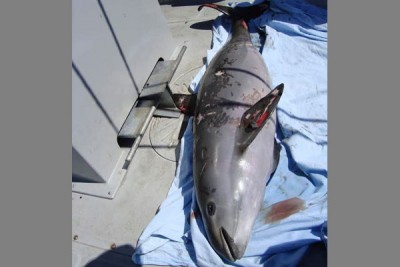
A report by the International Committee for the Recovery of
the Vaquita (CIRVA) has said that the vaquita is disappearing faster than
previously thought and it is estimated that there are now only 50 individuals
of this unique species in the Sea of Cortez.
CIRVA said that the decline of the world's most endangered
marine mammal has risen dramatically from 2013 to 2014 in their main range from
San Felipe, Baja California and Santa Clara and Puerto Peñasco, Sonora. Based
on sonar readings they have now estimated the mortality rate for the species at
almost 42% which is likely to prove unsustainable.
The previous estimate released in July last year with data
from 2011-2013 established a mortality of 18.5 percent and the existence of 97
individuals, 25 of them females of reproductive age.
At its recent meeting in San Diego, California, the
Scientific Committee of CIRVA warned that this rapid decline in the population
of the vaquita justifies strong action taken by Mexico to ban for two years the
use of gillnets in the area and increase the area of protection of the species.
The rapid decline of the vaquita is closely linked to the
increase in the illegal fishing for totoaba in the Upper Gulf of California.
This large fish is itself now on the CITES Red List as being endangered and their
swim bladders are considered a delicacy in China and fetch high fetch prices.
Nets set by fishermen to catch the totoaba also catch
vaquita and sea cows; both marine mammals and being unable to rise to the
surface to breathe, they simply drown in them.
CIRVA researcher Jorge Urbán said a new survey of the
vaquita protection zone will take place near the end of the year. If the
population is confirmed to be only 50 specimens it might have to be considered a lost cause, as it would be difficult for the species to recover.
“Even if current projects are applied thoroughly, I believe
it would be difficult for the vaquita to recover” he said.
Meanwhile, marine biologist Alejandro Olivera, coordinator
of public policies of the Mexican Center for Environmental Law (Cemda) in the
northwest said the only thing left is to abide by the letter of the law and the
urgent recommendations of CIRVA and stop the illegal traffic in totoaba over
the border in cooperation with the United States and China.
The vaquita is a cetacean, like whales and dolphins,
belonging to the family of porpoises, and is found only in Mexico and their
recovery becomes is even more in doubt when its reproduction cycle is taken
into consideration. The vaquita mates once every two years, and after a
gestation period of 11 months the cows bear a single calf.
Although mostly found in the north of the Sea Of Cortez, the vaquita has been occasionally spotted as far south as the waters around Los Cabos.